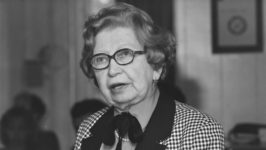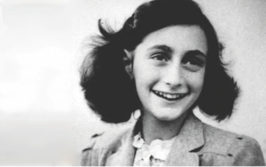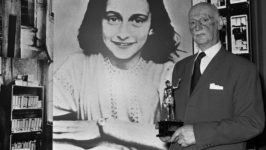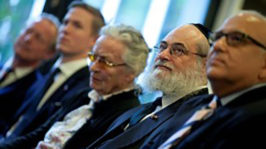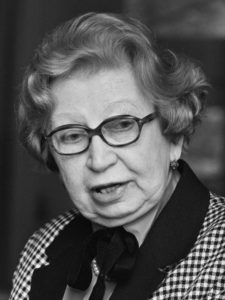To commemorate the 110th anniversary of the birth of Miep Gies, the foundation decided to institute an award named after this remarkable savior. Austrian by birth, Miep Gies is credited with recovering Anne Frank’s intimate diary.
Miep Gies was born in Austria on February 15, 1909, and was adopted at the age of 11 by a Dutch family. She lived the rest of her long life in the Netherlands.
For two years during the Nazi ocupation of the Netherlands Miep Gies and her husband Jan (a municipal employee whom she married in 1941), risked their lives as they smuggled food, supplies, and news from the outside with the purpose of helping Jews, who were being persecuted by the Nazis.
At the outbreak of World War II, Gies worked as a personal assistant to Otto Frank, Anne’s father and owner of a pectin factory in Amsterdam.
After the Nazi invasion in 1940, Otto Frank prepared a secret annexed room behind a bookcase on the top floor of his company’s offices, located at 263 Prisengracht Street. Otto, his wife Edith and their daughters, Margot and Anne were hiding in that annex, leaving a false trail indicating that the family had fled to Switzerland.
Shortly thereafter, the hiding place was also used by other Jews: the Van Pels family and Fritz Pfeffer, a dentist of the Gies family, a total of 8 people.
Miep Gies acted as protector of the hidden Jews and especially as confidant of the adolescent Anne Frank, bringing her paper for her diary and, on one occasion, a pair of used high heeled shoes.
The heroic performance of Gies ended on August 4, 1944, when the Frank family and all the others from the secret annex were reported, arrested and sent to concentration camps. Even today it is not clear who betrayed them.
When the Gestapo arrived, Gies was in the office on the ground floor. She recognized the Viennese accent in the voice of one of the Nazi officers and that fact helped in saving her life.
Later, at considerable personal risk, she went to the Gestapo headquarters to try to negotiate the release of the detainees, but to no avail. Finally, she returned to the hiding place and found Anne’s diary, with its pages scattered on the floor.
Gies intended to return it to the author, knowing how important the diary had been to her. She kept it safe,without reading a word. Almost a year later, Anne’s father, Otto, returned from Auschwitz. He knew that his wife and friends had not survived, but he still hoped that his two daughters, Margot, 18, and Anne, 15, would have been saved.
Two months later, he received a letter confirming that both girls had died in Bergen-Belsen in March 1945, less than a month before British soldiers liberated the camp.
Miep Gies was with him when he received the news and could not find the words to comfort him. Then he remembered Anne’s diary. She took it from the desk and gave it to him, saying, “Here is the legacy of your daughter Anne for you.”
In this way, Miep Gies protected not only the Franks and other hidden Jews, but also managed to rescue the Diary of Anne Frank from anonymity.
Anne had written her diary between 1942 and 1944 in the Amsterdam hideout, making it the most read document about the Holocaust, launching its author into immortality.
Amsterdam, October 28, 2013
(L to R) Brian Mooyaart (Barbara’s son), Raoul Mooyaart (Barbara’s grandson named Raoul in honor of Raoul Wallenberg), Barbara Mooyaart Doubleday, Chief Rabbi Binyomin Jacobs, and Danny Rainer from the Wallenberg Foundation
This testimony has become a symbol of humanity, tolerance, optimism and the will to live, transforming Anne Frank into a reference for millions of young people in search of identity and freedom.
Finally published in 1947, The Diary of Anne Frank became, after the Bible, the world’s best-selling nonfiction book.
In fact, the diary became famous through the English translation, brilliantly done by the late Barbara Mooyaart Doubleday,
For the rest of her life, Miep Gies dedicated herself to spreading the legacy of Anne Frank, answering letters from all around the world. In 1987 she published a book, Anne Frank Remembered. She wrote, “I’m not a hero. I’m at the end of the long line of good Dutchmen who did what I did and more, a lot more, during those dark and terrible times….”
She was decorated by Queen Beatrix of the Netherlands for her heroism and dedication, and the Israeli Holocaust Museum Yad Vashem bestowed on her and her husband the titles of “Righteous among the Nations.”
In 1996, Jon Blair’s film, Anne Frank Remembered, won an Oscar for the best feature length documentary. Blair took Miep Gies to the ceremony in Hollywood, and while they were heading to the awards in a limo, she commented that she had agreed to come because Anne Frank had always wanted to be famous and had loved Hollywood. Blair took Miep Gies to the stage when he gave his acceptance speech, and the audience gave her a standing ovation.
Jan Gies died at 101 old in 2010.
In a special statement, the Wallenberg Foundation highlighted “the heroism and humanity of Miep Gies,” who not only risked her life to try to save those persecuted by Nazism, but made it possible for the world to know the Diary of Anne Frank; and after the war, she dedicated her life to educating young generations about the terrible time she had lived in. The foundation also resolved to institute the ‘Miep Gies Medal’, which will be awarded to those who excel in their work of defending human rights.

